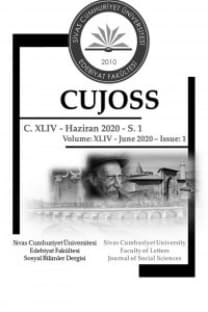Multiple Approaches in Public Policy Analysis: A Critique of Positivist Approach
Kamu Politikası Analizinde Çoklu Yaklaşımlar: Positivist Yaklaşımın Bir Eleştirisi
___
- ACKOFF, L. Russell. (1974), Redesigning the Future: A Systems Approach to Societal Problems. New York: John Wiley and Sons.
- ARİFF, Mohamed. (2007), Comment on "Asian Currency Crisis and the International Monetary Fund, 10 Years Later: Overview" Asian Economic Policy Review Vol.:2, No:1, p. 50–51
- ALLİSON, T. Graham. (1971), Essence of Decision: Explaining the Cuban Missile Crisis, Boston MA: Little Brown
- BRAYBROOKE, David and Charles, E. Lindblom. (1963), A Strategy of Decision: Policy Evaluation and Social Process. Toronto: Collier- Macmaian Company, Ltd.
- BOBROW, B. Davis. and John S.Dryzek. (2000), Policy Analysis by Design, Pittsburgh: University of Pittsburgh Press.
- CAMPBELL, T. Donald. and Stanley C. Julian. (1963), Experimental and Quasi-Experimental Designs for Research, Chicago: Rand McNally College Publishing Company.
- CAMPBELL, T. Donald, William R. Shadish, and Thomas D. Cook, (2002), Experimental and Quasi-Experimentation for Generalized Casual Inference, Boston: Houghton Mifflin Chicago, IL: Rand Mc Nally College Publishing Company.
- COLDWELL, David A. L. (2007) “Is Research that is both Causally Adequate and Adequate on the Level of Meaning Possible or Necessary in Business Research? A Critical Analysis of Some Methodological Alternatives”, The Electronic Journal of Business Research Methods 5(1):1-10
- COOK, D. Thomas, Donald T. Campbell. (1979), Quasi-experimentation:Design & Analysis Issues for Field Settings, Boston: Houghton Mifflin.
- COOK, D. Thomas and Charles S. Reichardt. (1979) “Beyond Qualitative Versus Quantitative Methods, in Thomas D. Cook and Charles S. Reichardt” (ed.), Qualitative and Quantitative Methods in Evaluation Research, Beverly Hills, CA: Sage), Vol. 1.
- COOK, D. Thomas (1985), “Postpositivist Critical Multiplism”, in R. L. Shotland and M. M. Mark (ed.), Social Science and Social Policy, Beverly Hills, CA: Sage.
- DATTA, Louis, E.(2001). “Chalenges and Strategie for Successfully Carrying Out Mixed Method Evaluations”, Evaluation Journal of Australasia 1(2) (new series): 33-40
- DİESİNG, Paul. (1991), How Does Social Sciences Work? Reflections on Practice, Pittsburgh, PA: University of Pittsburgh Press.
- DRYZEK, J.S. (1983), “Don't Toss Coins in Garbage Cans: A Prologue to Policy Design”, Journal of Public Policy”, Vol.:3, No: 4, 345-368
- DUNN, N. Willam. (1995), “Testing Rival Hypotheses with Pragmatic Eliminative Induction: The Case of National Maximum Speed Limits”, Working paper, Pittsburgh, PA: University of Pittsburgh, Graduate School of Public and International Affairs.
- DUNN, N. Willam. (1997), “Probing the Boundaries of Ignorance in Policy Analysis”, American Behavioral Scientist, Vol.: 40, No: 3, 277-298.
- DUNN, N. Willam. (1998) “Campbell’s Experimenting Society – Prospect and Retrospect”, in Dunn, W. N. (ed.), The Experimenting Society: Essays in Honor of Donald T. Campbell New Brunswick, NJ: Transaction Books.
- DUNN, N. Willam. (2000), Public Policy Analysis: An Introduction, Englewood Cliffs: Prentice Hall.
- FİSCHER Frank, John Forester. (1993), The Argumentative Turn in Policy Analysis and Planning, Durham: Duke University Press.
- HAWKESWORTH, E. Marry. (1988), Theoretical Issues In Policy Analysis, New York: State University of New York Press.
- KELLY, M., Steven Maynard-Moody. (1993). Policy Analysis in the Post- Positivist Era: Engaging Stakeholders in Evaluation the Economic Development Districts Program. Public Administration Review, 53(2), 135-142.
- KİNGDON, W. Kingdon (1995), Agendas, Alternatives and Public Policies, New York: Harper Collins.
- KOOP, J. Sima (2008), "Science, Analysis or Rhetoric? Teaching Public Policy in the Post-Postivist Era" Presented at 2008 Annual Meeting of the Canadian Political Science Association. http://www.cpsaacsp. ca/template_e.cfm?folder=conference&page_name=session30pm.h tm (Accessed in 21.05.2008).
- LASWELL, D. Harold (1971), A Pre-View of Policy Sciences, New York: American Elseiver.
- LİNDBLOM, Charles, (1959), “The Science of Muddling Through”, Public Administration Review 19 (2):.421-440.
- LİNDBLOM, E. Charles, David K. Cohen. (1979), Usable Knowledge: Social Science and Problem Solving, New Haven, CT: Yale University Press.
- LİNDBLOM, E. Charles. (1990), Inquiry and Change New Haven, CT: Yale University Press.
- LİNSTONE, Harold. (1984) Multiple Perspectives for Decision Making, New York: North-Holland.
- MACRAE, Duncan, Jr. (1993), “Guidelines for Policy Discourse: Consensual Versus Adversarial, In Fischer, Frank and John Forester” (ed.), The Argumentative Turn in Policy Analysis and Planning, Durham, N.C.: Duke University Press.
- MAJONE, Giandomenico. (1992), Evidence, Argument and Persuasion in the Policy Process, New Haven, CT: Yale University Press.
- OPPERMAN, Martin (2000), “Triangulation-A Methodological Discussion”, International Journal of Tourism Research 2 (2): 141-146
- SABATİER, A. Paul. (1999), Theories of Policy Process, Boulder, Colorado: Westview Press.
- SABATİER, A. Paul, Hank C. Jenkins-Smith. (1999), “The Advocacy Coalition Framework” in Sabatier, Paul. A (edt), Theories of Policy Process. Boulder, Colorado: Westview Press.
- SHAFRİTZ, M., Jay, Russell, E. and Borick, C. (2006), Introducing Public Administration. San Francisco, CA: Addison Wesley Longman, Inc.
- SİMON, A. Herbert. (1997), Administrative Behavior: A study of Decision- Making Processes in Administrative Organizations, Simon New York: Free Press, c1997
- STONE, Deborah. (2001), Policy Paradox: The Art of Political Decision Making. New York: W.W. Nortion & Company, Inc.
- TOULMİN, Stephan, Rieke Richard, Janik Alan. (1984) An Introduction to Reasoning. 2nd ed. New York: Macmillan.
- TRUE, L. James, Bryan D. Jones, Frank R. Baumgartner. (1999), “Punctuated- Equilibrium Theory” in Sabatier, A. Paul (edt), Theories of Policy Process. Boulder, Colorado: Westview Press.
- WEİSS, Carol, ed. (1977), Using Social Science Research in Policy Making. Lexington Books, Lexington, Mass.
- WİLDAVSKY, Aaron, (1964). The Politics of the Budgetary Process, Boston MA: Little, Brown
- WİLDAVSKY, Aaron. (1979). Speaking Truth to Power: The Art and Craft of Policy Analysis, Transaction Books: New Brunswick, NJ.
- YANOW, Dvora. (1993). “The Communication of Policy Meanings: Implementation as Interpretation and Text”, Policy Sciences, Vol.:26, No: 1, 41-61.
- ISSN: 1305-5143
- Yayın Aralığı: 2
- Yayıncı: Sivas Cumhuriyet Üniversitesi Edebiyat Fakültesi
Multiple Approaches in Public Policy Analysis: A Critique of Positivist Approach
Süleyman ÇELİK, Sıtkı ÇORBACIOĞLU
Strain, Social Bonding Theories and Delinquency
21. Yüzyılın Liderlik Anlayışına Bakış
1867 Konya Çarşısı Yangını ve Etkileri Üzerine Bir İnceleme Denemesi
Niyazi Berkes’in Türk Kitle İletişim Tarihine Katkıları
